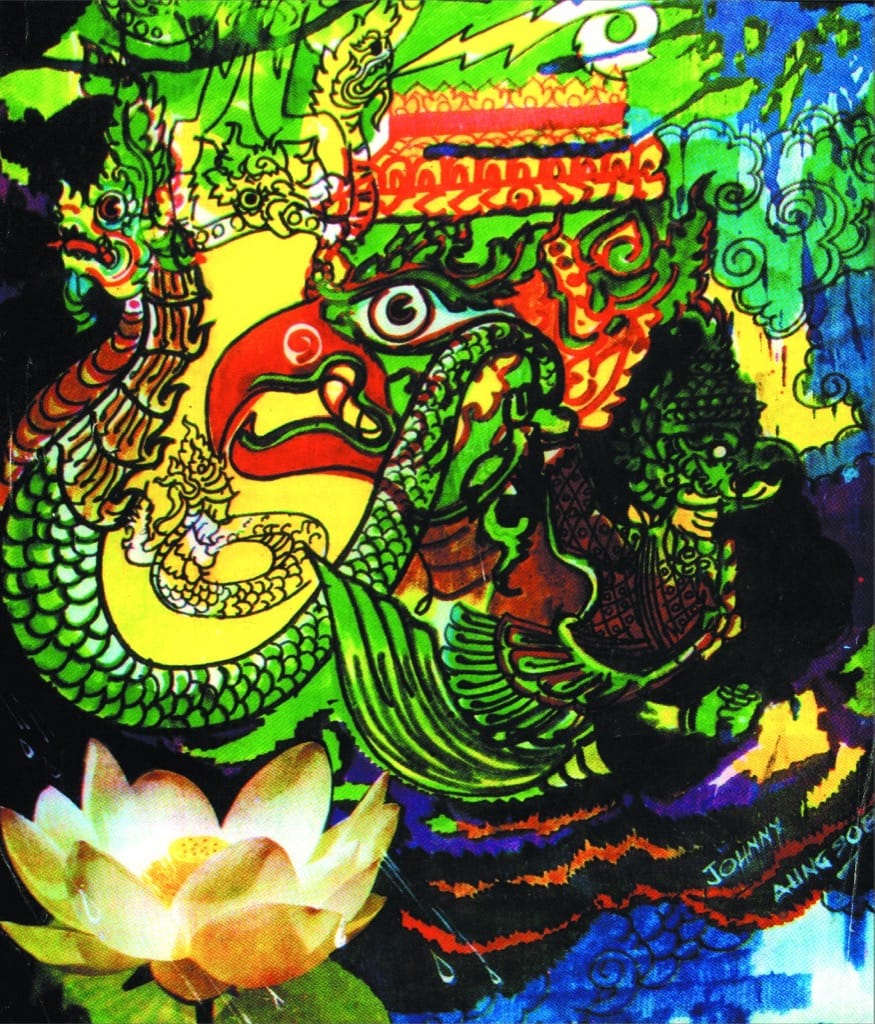Untitled | Unknown publication (, 1980)
This vibrant illustration brings together in the same space two rival mythical creatures from Buddhist and Hindu mythology: the garuda and naga. These beasts have their origins in a number of ancient Indian texts such as the Hindu Vedas, Puranas and Buddhist Jatakas. They share the same father but their enmity stems from that between their mothers.
The garuda is a massive and majestic part-bird part-human creature that serves as Lord Vishnu’s mount. It signifies bravery, longevity and strength and is a Burmese cultural symbol. It also features prominently in other Southeast Asian countries such as Indonesia and Thailand. The naga on the other hand, is a divine serpentine being.
There is a considerable use of kanut, a traditional Burmese ornamentation device typically used in painting, sculpture and crafts. Here, kanut-tek, kwekhsek and a simplified lotus hsekpan are used to decorate the heads of the naga and garuda, further emphasising their importance and power. This work incorporates both collage and illustration with felt tip pens. The palette of mostly primary colours are pure and rich. The ink is applied spontaneously. The runs and bleeds are deliberate and enhance the work. They are characteristic of Aung Soe’s free-flowing style.
In this undated illustration from around 1980, there are multiple depictions of the rival garuda and naga within the same space. The garuda (or galon in Burmese) is represented in two main ways, suggesting an illusory space: the giant central eagle head and a smaller garuda with a human torso and raised arms. Their facing opposite directions suggests movement in the space. However, the former demands our attention with its large red mass of a beak and piercing eyes. Its eye tapers towards the right and directs our gaze along the meandering serpent body of the naga. In this way, no one creature is the main subject of the image and the two compete for dominance within the space. This arrangement parallels the narrative and the rivalrous relationship between the two creatures. There are also smaller and less ornate manifestations of the naga and garuda in the background. For example, in the top left corner, a garuda is shown eating a naga, conforming to the myth whereby the Hindu god Indra offers the nagas to garuda as food.
Note that the term “background” should be used with caution. The space seems to be illusory and unreal as the figures overlap inconsistently and do not conform to any scheme of perspective or scale. This not only makes for an extremely dynamic composition, but also mirrors their otherworldly nature and celestial presence. The two however are not of the same realm and are polar divinities. The garuda embodies the upperworld, sky and male presence, whereas the naga, the underworld, water and female. Curvilinear motifs which possibly represent clouds and sky appear in the upper right area, disappear behind the figures, before resurfacing subtly at the bottom in blue. At the bottom left is a cutout of a floating lotus flower which suggests water, the natural element and domain of the naga. Following this vein, the two worlds of sky and water seem to converge. Perhaps by depicting them in the same space, Aung Soe skillfully bridges the chasm between upper and underworlds, and draws together opposing elements and concepts represented by the two mythical beings. The running ink further merges the two realms.
Interestingly, this illustration is signed “Johnny Aung Soe”. This adoption of an English name is very unusual as Aung Soe typically signed his works either using a symbol of a circle surrounded by a ring of smaller circles, “Aung Soe” in Burmese and Roman alphabets, or both.
Bibliography
- Aye Myint. Burmese Design Through Drawings. Bangkok, Thailand: Silpakorn University, 1993.
- Ker, Yin. “Modern Burmese Painting According to Bagyi Aung Soe.” Journal of Burma Studies 10 (2005): 83-157. Accessed April 9, 2016. https://www.academia.edu/5301730/Modern_Burmese_Painting_According_to_Bagyi_Aung_Soe
- Wessing, Robert. “Symbolic Animals in the Land between the Waters: Markers of Place and Transition.” Asian Folklore Studies 65, no. 2 (2006): 205-39. Accessed April 9, 2016. http://www.jstor.org/stable/30030399
- Williams, George M. Handbook of Hindu mythology. New York, NY: Oxford University Press, 2003.
